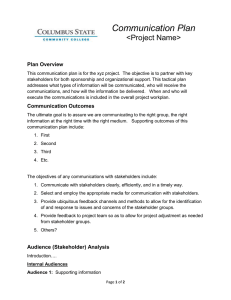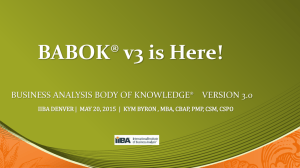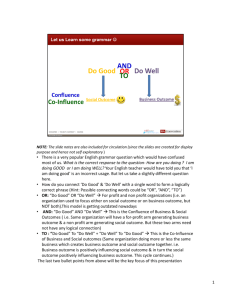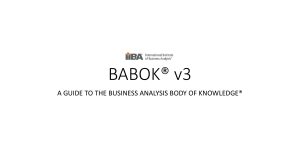Requirements Lifecycle according to BABOK
advertisement
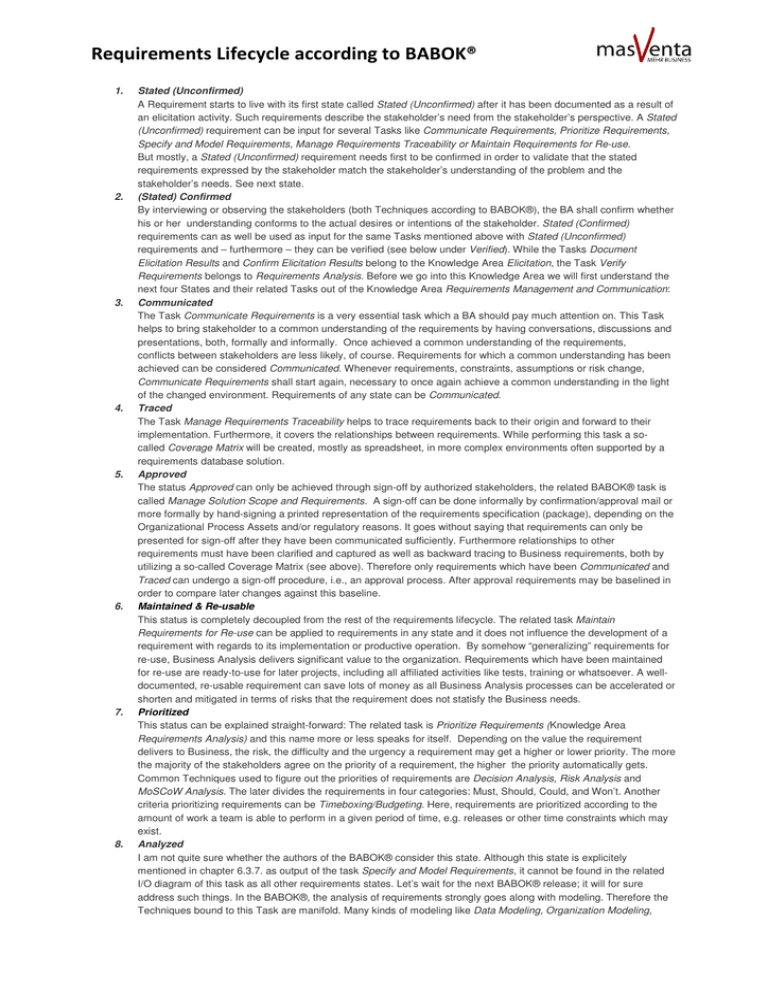
Requirements Lifecycle according to BABOK® 1. 2. 3. 4. 5. 6. 7. 8. Stated (Unconfirmed) A Requirement starts to live with its first state called Stated (Unconfirmed) after it has been documented as a result of an elicitation activity. Such requirements describe the stakeholder’s need from the stakeholder’s perspective. A Stated (Unconfirmed) requirement can be input for several Tasks like Communicate Requirements, Prioritize Requirements, Specify and Model Requirements, Manage Requirements Traceability or Maintain Requirements for Re-use. But mostly, a Stated (Unconfirmed) requirement needs first to be confirmed in order to validate that the stated requirements expressed by the stakeholder match the stakeholder’s understanding of the problem and the stakeholder’s needs. See next state. (Stated) Confirmed By interviewing or observing the stakeholders (both Techniques according to BABOK®), the BA shall confirm whether his or her understanding conforms to the actual desires or intentions of the stakeholder. Stated (Confirmed) requirements can as well be used as input for the same Tasks mentioned above with Stated (Unconfirmed) requirements and – furthermore – they can be verified (see below under Verified). While the Tasks Document Elicitation Results and Confirm Elicitation Results belong to the Knowledge Area Elicitation, the Task Verify Requirements belongs to Requirements Analysis. Before we go into this Knowledge Area we will first understand the next four States and their related Tasks out of the Knowledge Area Requirements Management and Communication: Communicated The Task Communicate Requirements is a very essential task which a BA should pay much attention on. This Task helps to bring stakeholder to a common understanding of the requirements by having conversations, discussions and presentations, both, formally and informally. Once achieved a common understanding of the requirements, conflicts between stakeholders are less likely, of course. Requirements for which a common understanding has been achieved can be considered Communicated. Whenever requirements, constraints, assumptions or risk change, Communicate Requirements shall start again, necessary to once again achieve a common understanding in the light of the changed environment. Requirements of any state can be Communicated. Traced The Task Manage Requirements Traceability helps to trace requirements back to their origin and forward to their implementation. Furthermore, it covers the relationships between requirements. While performing this task a socalled Coverage Matrix will be created, mostly as spreadsheet, in more complex environments often supported by a requirements database solution. Approved The status Approved can only be achieved through sign-off by authorized stakeholders, the related BABOK® task is called Manage Solution Scope and Requirements. A sign-off can be done informally by confirmation/approval mail or more formally by hand-signing a printed representation of the requirements specification (package), depending on the Organizational Process Assets and/or regulatory reasons. It goes without saying that requirements can only be presented for sign-off after they have been communicated sufficiently. Furthermore relationships to other requirements must have been clarified and captured as well as backward tracing to Business requirements, both by utilizing a so-called Coverage Matrix (see above). Therefore only requirements which have been Communicated and Traced can undergo a sign-off procedure, i.e., an approval process. After approval requirements may be baselined in order to compare later changes against this baseline. Maintained & Re-usable This status is completely decoupled from the rest of the requirements lifecycle. The related task Maintain Requirements for Re-use can be applied to requirements in any state and it does not influence the development of a requirement with regards to its implementation or productive operation. By somehow “generalizing” requirements for re-use, Business Analysis delivers significant value to the organization. Requirements which have been maintained for re-use are ready-to-use for later projects, including all affiliated activities like tests, training or whatsoever. A welldocumented, re-usable requirement can save lots of money as all Business Analysis processes can be accelerated or shorten and mitigated in terms of risks that the requirement does not statisfy the Business needs. Prioritized This status can be explained straight-forward: The related task is Prioritize Requirements (Knowledge Area Requirements Analysis) and this name more or less speaks for itself. Depending on the value the requirement delivers to Business, the risk, the difficulty and the urgency a requirement may get a higher or lower priority. The more the majority of the stakeholders agree on the priority of a requirement, the higher the priority automatically gets. Common Techniques used to figure out the priorities of requirements are Decision Analysis, Risk Analysis and MoSCoW Analysis. The later divides the requirements in four categories: Must, Should, Could, and Won’t. Another criteria prioritizing requirements can be Timeboxing/Budgeting. Here, requirements are prioritized according to the amount of work a team is able to perform in a given period of time, e.g. releases or other time constraints which may exist. Analyzed I am not quite sure whether the authors of the BABOK® consider this state. Although this state is explicitely mentioned in chapter 6.3.7. as output of the task Specify and Model Requirements, it cannot be found in the related I/O diagram of this task as all other requirements states. Let’s wait for the next BABOK® release; it will for sure address such things. In the BABOK®, the analysis of requirements strongly goes along with modeling. Therefore the Techniques bound to this Task are manifold. Many kinds of modeling like Data Modeling, Organization Modeling, Requirements Lifecycle according to BABOK® Process Modeling and the commonly used diagram methodologies found in UML and others are mentioned in the BABOK®. Although the BA does not need to know each methodology in detail, he should at least know for what purposes he should use which approach. 9. Verified Verify Requirements ensures that requirements are of a sufficient quality to be processed further. Requirements which do not provide enough information to be reasonably reviewed and validated by the stakeholders will not be verifiable due to lack of quality. Further er processing of such requirements does not make sense that is why they should be refined or dropped, alternatively. To mention only one of the quality criteria, I would like to emphasize that a requirement must be testable in order to prove that a requirement require has been fulfilled. 10. Validated The Task Validate Requirements needs Verified requirements as input in order to validate their Business value. Validated means that the requirements’ value can be demonstrated to the Business stakeholders and that they are aligned with the goals and objectives of the Business. 11. Allocated This state can only be reached if the requirement has been Prioritized and Approved beforehand. By performing the task Allocate Requirements out of the Knowledge Area Solution Assessment and Validation, Validation the implementation and/or deployment of requirements in terms of point in time is fixed. This may depend on release cycles, on available resources or on other constraints Source: www.bapblog.de Requirement‘s Eleven Stated Allocated Confirmed Communicated Validated Verified Traced Analyzed Approved Priorized Maintained for Re-Use Source: CBAP® Prep Course, 2011 by masVenta m Business GmbH, unmodified copies allowed.


